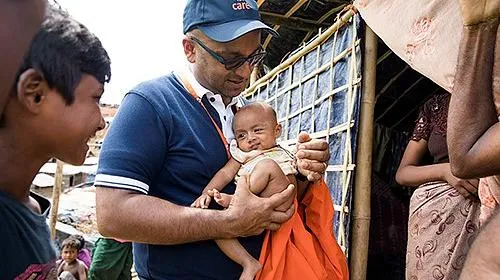COX’S BAZAR (Sept. 18, 2017) — In the past three weeks, more than 400,000 people from Myanmar have fled to Bangladesh after an escalation of violence in Myanmar’s northern Rakhine State. Most of the refugees, around 80 percent, are women, children and small babies.
“The situation of the refugees is worsening by the minute. They came to Bangladesh with nothing but the clothes they were wearing,” says Zia Choudhury, CARE Bangladesh’s country director. “They walked for long distances for days to reach safety. In Cox’s Bazar, close to the Myanmar border, families are sleeping in fields and on muddy paths. They have nowhere else to go. The people who have fled Rakhine State are in desperate need of clean drinking water, food, medical help and a safe place to sleep.“
CARE has already allocated some initial funds to start its response to the Myanmar Refugee Crisis. CARE Bangladesh’s emergency team is already working in Cox’s Bazar district. CARE has started distributing food to over 3,500 people, for an initial period of 15 days. To respond to the most urgent needs over the months ahead, CARE is appealing for $10 million.
As of Sept. 15, around 159,000 people are staying in a makeshift settlement camp with 229,000 arrivals in new spontaneous sites, and 21,000 in host communities. The Government of Bangladesh and local authorities are working hard to meet the needs of the refugees. Local Bangladeshi families, with few resources themselves, are taking in the refugees and have been supporting them however they can.
But the scale of this crisis means that much more help is needed. CARE is concerned that the ongoing rains will further worsen the situation. “People will need to build more stable shelter as soon as possible. They will need strong tarpaulin, bamboo and rope to remain safe even during the rains,” says Choudhury.
CARE has worked in Bangladesh since 1949, and has extensive experience responding to humanitarian disasters. CARE has worked in Cox’s Bazar district, where most refugees have sought shelter, for many years, working in the areas of food security, disaster risk reduction, women’s empowerment and emergency response. In the last five years, CARE Bangladesh has supported more than 450,000 people with life-saving assistance.
About CARE
Founded in 1945, CARE is a leading humanitarian organization fighting global poverty. CARE has more than seven decades of experience helping people prepare for disasters, providing lifesaving assistance when a crisis hits, and helping communities recover after the emergency has passed. CARE places special focus on women and children, who are often disproportionately affected by disasters. Last year CARE worked in 94 countries to reach 80 million people, including more than 11 million through emergency response and humanitarian aid. Learn more at care.org.
Media Contacts
Nicole Harris, nharris@care.org, 404-735-0871
Brian Feagans, bfeagans@care.org, 404-979-9453

